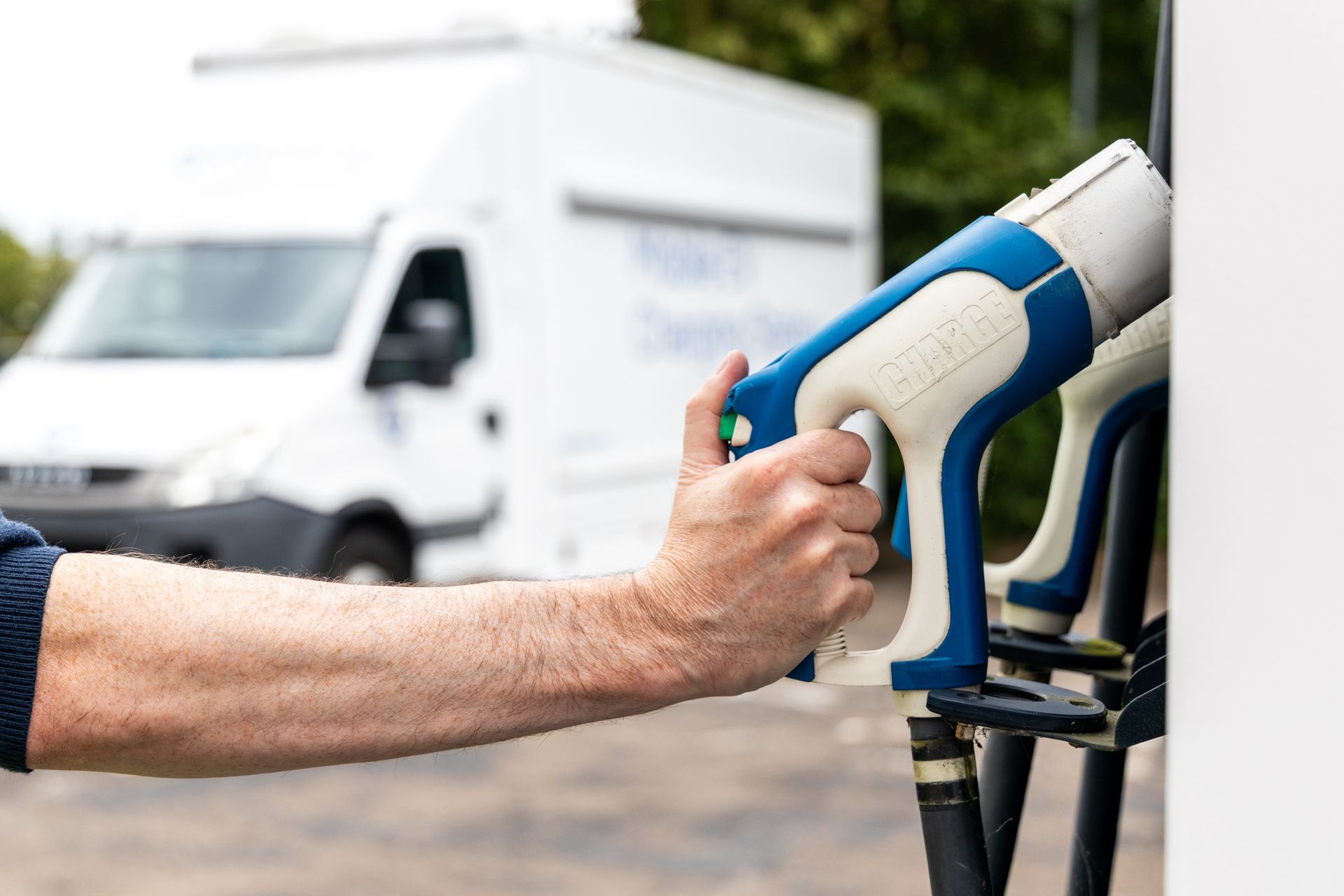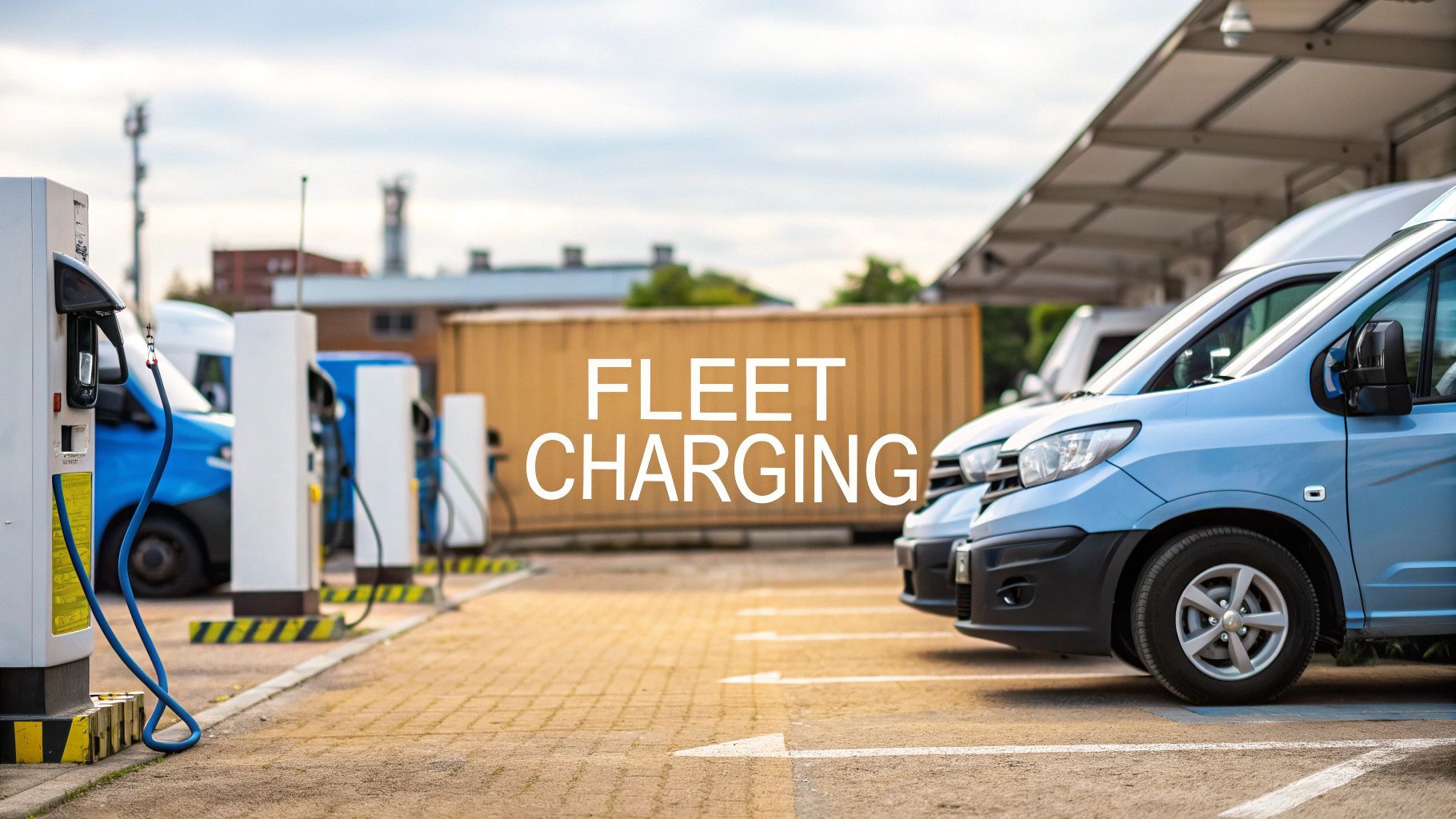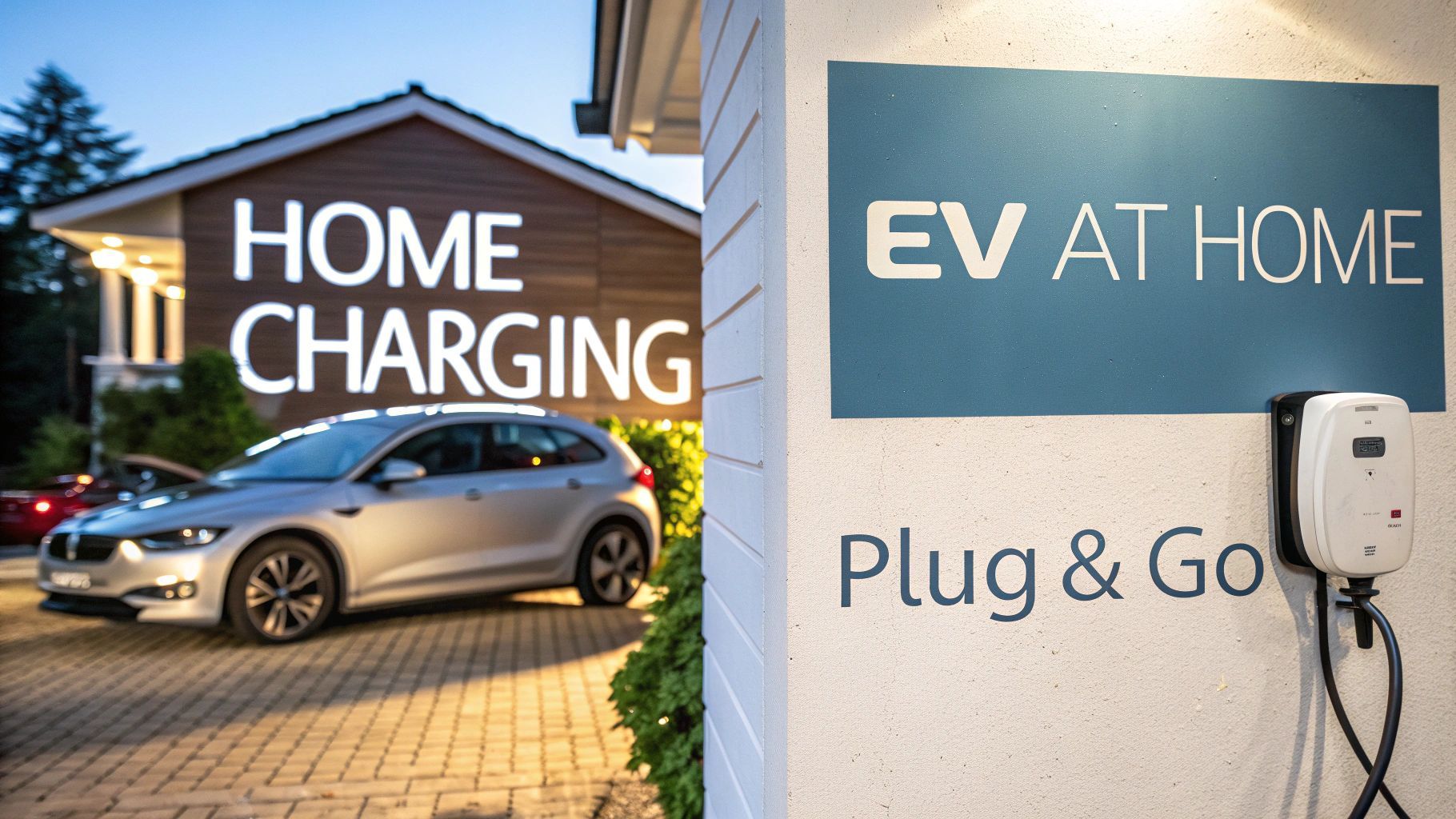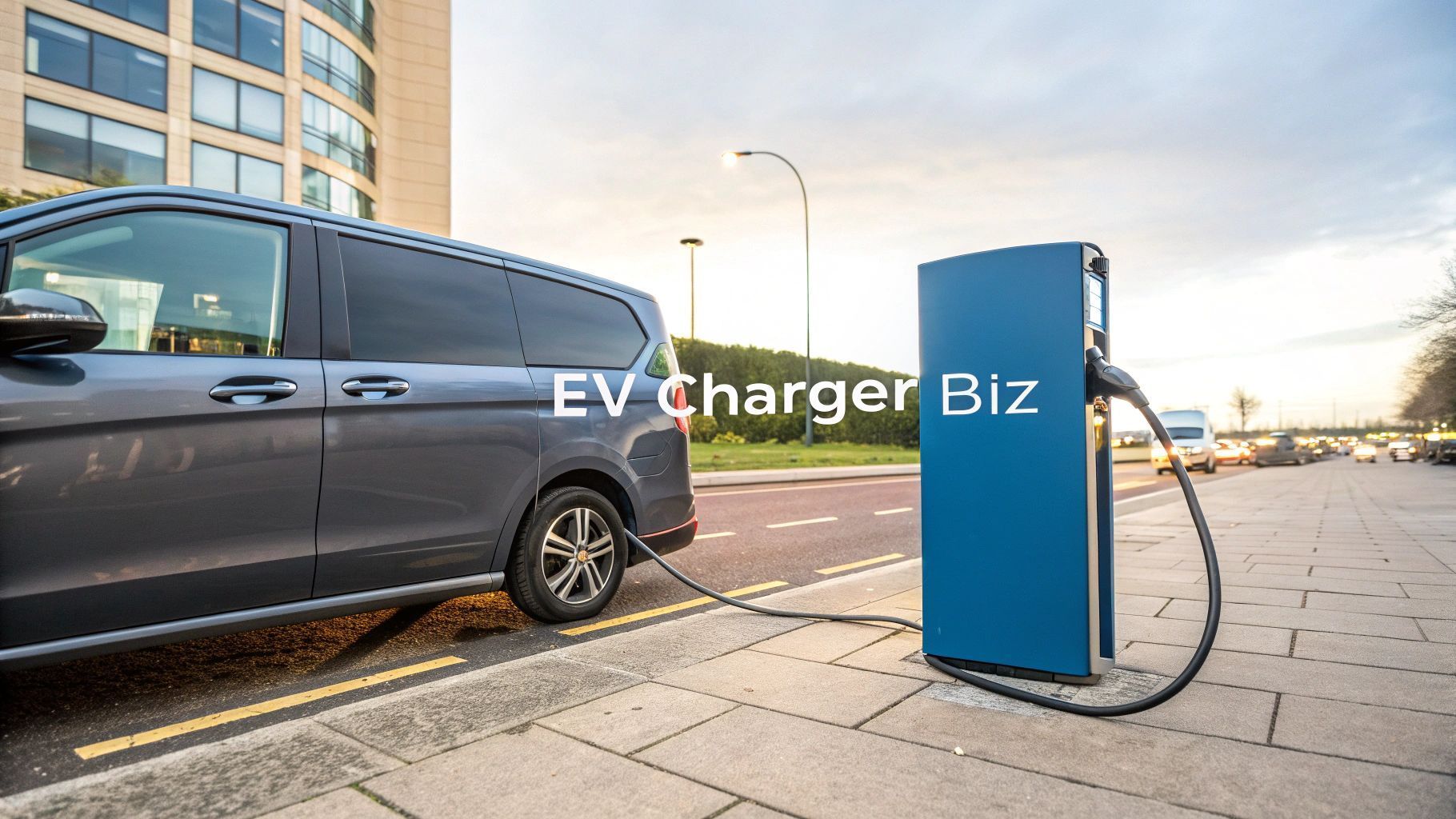Your Guide to Every EV Charger Connector
Dipping your toes into the electric vehicle world can feel a bit like learning a new language, with terms like ‘Type 2’ and ‘CCS’ thrown around. In simple terms, an EV charger connector is the physical plug that connects your car to a charging point, letting electricity flow into the battery.
Think of it like phone chargers from a decade ago. Different brands had their own unique plugs but now, thankfully, a clear standard is emerging for UK drivers.
Understanding Your EV Charger Connection
Choosing an electric car is an exciting step towards greener, cheaper motoring but the jungle of different plugs and sockets can seem a little intimidating at first. The connector is the crucial handshake between your car and its power source and knowing which one you need is fundamental.
It’s not just about whether the plug fits. The type of connector dictates where you can charge, how you charge and most importantly, how quickly you can get back on the road.
For most drivers in the UK, things have become much simpler over time. The Type 2 connector is now the universal standard for AC charging —that’s the kind of charging you’ll do overnight at home or when topping up at the supermarket. This standardisation means you can count on a consistent connection across a massive network of chargers.
When it comes to rapid charging on longer journeys, the picture is becoming just as clear.
Why the Right Connector Matters
The connector you use has a direct impact on your entire charging experience. Using the correct one ensures safety, efficiency and gives you access to the fastest possible charging speeds your vehicle can handle.
For instance, DC rapid chargers use different, bulkier connectors like CCS. These are designed to deliver a huge amount of power directly to your car’s battery, bypassing its onboard converter for a much quicker top-up.
Understanding your car’s specific connection is the first step towards stress-free EV ownership. It gives you the confidence to plan journeys and make the most of public charging without any nasty surprises.
This guide is here to demystify every EV charger connector you’re likely to come across. We’ll break down which plug fits which car and how to choose the right charging solution for any situation.
For a deeper dive into which vehicles use which standards, our guide on EV charging compatibility provides a detailed breakdown. And for a practical look at how this all works for a specific brand, you can learn more about how to charge a Tesla at home.
The Main EV Connector Types in the UK
Think of an EV charger connector as the crucial handshake between your car and its power source. It might seem complicated at first but in the UK, a few key standards dominate the scene. Once you know what to look for, it's actually pretty straightforward.
The simplest way to understand these connectors is to split them into two camps: AC (Alternating Current) and DC (Direct Current). AC is for the slower, everyday top-ups you do at home or work. DC is the high-speed stuff, the rapid charging you rely on during long journeys to get back on the road in minutes, not hours.
This diagram gives a great visual overview of the main connector types you'll come across.
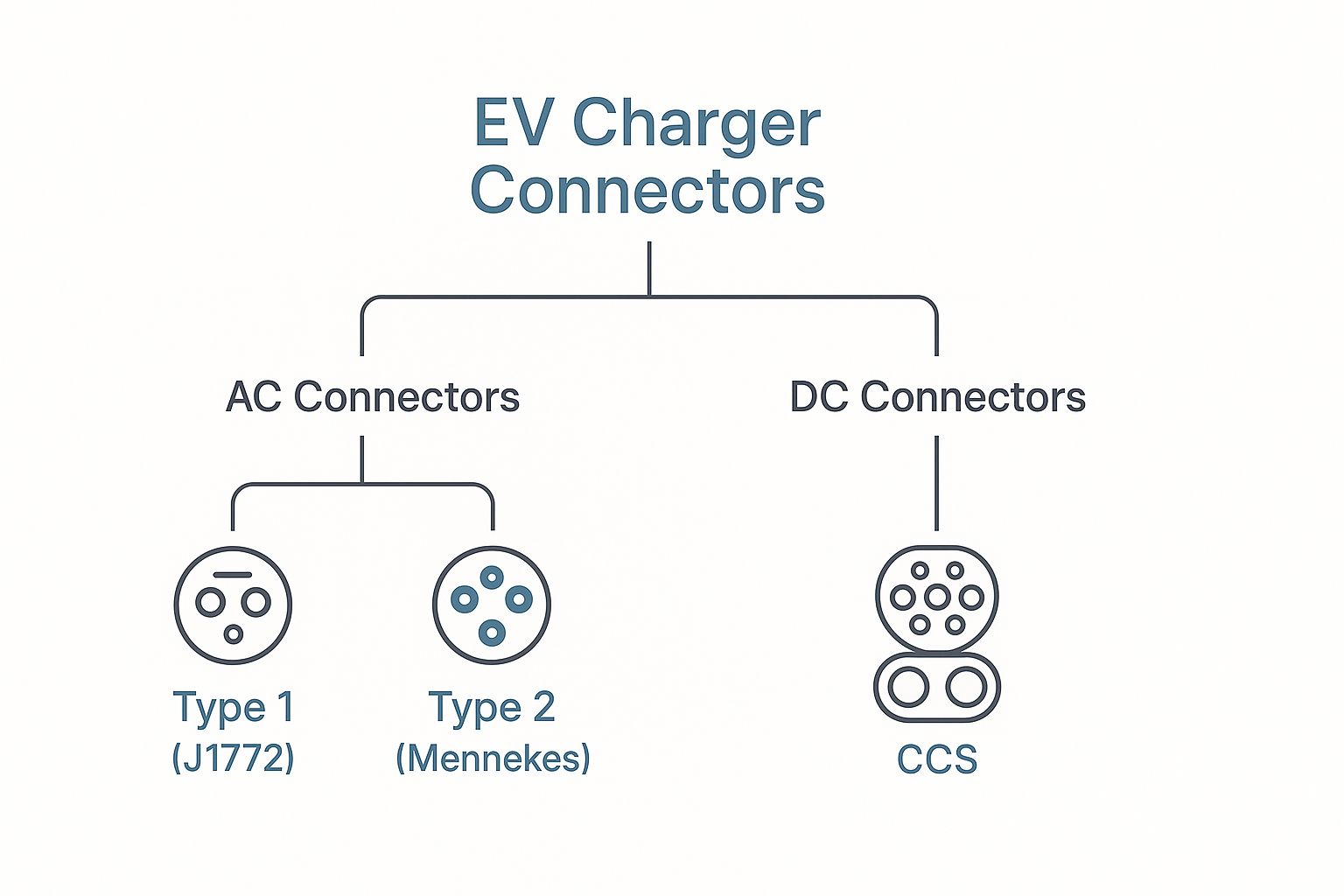
As you can see, the connectors are divided between the slower AC and faster DC charging standards. In the UK, the Type 2 plug is by far the most common for day-to-day use.
To make things clearer, here’s a quick comparison of the main connectors you'll find across the UK.
UK EV Charger Connector Comparison
This table breaks down the key players in the UK charging landscape, showing what they're used for and which cars typically have them.
| Connector Type | Charging Type | Typical Power | Commonly Found On |
|---|---|---|---|
| Type 2 | AC | 3.7kW - 22kW | Virtually all modern EVs in the UK & Europe |
| CCS | DC | 50kW - 350kW+ | Most modern European and American EVs (e.g., VW, BMW, Tesla) |
| CHAdeMO | DC | Up to 50kW | Older Japanese models (e.g., Nissan Leaf, Mitsubishi Outlander) |
| Type 1 | AC | Up to 7.4kW | Older imported Asian models and some North American cars |
This table shows just how dominant Type 2 and CCS have become, forming the backbone of the UK's public and private charging network. Now let's dive into what makes each one different.
Type 2: The UK Standard for AC Charging
The Type 2 connector is the undisputed champion of AC charging across the UK and Europe. If you buy a modern electric car here, it's almost guaranteed to have a Type 2 inlet. Simple as that.
This seven-pin connector is incredibly versatile. It handles single-phase power for home charging (up to 7kW ) just as easily as it manages three-phase power for faster destination charging (up to 22kW ). Its design also includes a neat locking mechanism that secures the plug to the vehicle, so there's no risk of it being accidentally pulled out.
Because it's the standard, you'll find Type 2 sockets everywhere—from your local supermarket car park to workplace chargers. For any UK driver, having a quality rapid charger cable is an essential bit of kit for tapping into this vast network.
CCS: The Go-To for Rapid DC Charging
When you're on a long haul and need to add serious mileage fast, you’ll be looking for a Combined Charging System (CCS) connector. This is the main standard for DC rapid charging in the UK and Europe.
The genius of the CCS design is how it cleverly combines connectors. It simply adds two large DC power pins below a standard Type 2 socket, creating one port on your car that accepts both a slow AC Type 2 plug and a fast DC CCS plug.
This elegant integration is why most new EVs come with a CCS port. It gives drivers maximum flexibility, allowing them to use the entire public charging network without needing different sockets cluttering up their car.
Other Connectors: CHAdeMO and Type 1
While Type 2 and CCS run the show, you might still bump into a couple of others. The CHAdeMO connector is another rapid DC standard, mostly found on older models from Japanese manufacturers like the original Nissan Leaf and the Mitsubishi Outlander.
Although CHAdeMO was once a strong rival to CCS, it's now being phased out on new cars sold in Europe. That said, many rapid charging hubs still provide a CHAdeMO connector to support the thousands of compatible vehicles still on the road.
Finally, there’s the Type 1 connector , a five-pin AC plug that was the standard in North America and on some older Asian vehicles imported to the UK. It’s a rare sight these days but adaptors are available if you need to connect a Type 1 car to a more common Type 2 charging point.
How Connectors Determine Your Charging Speed
The type of plug you use to charge your EV has a direct, and massive, impact on how quickly you’ll be back on the road. Not all connectors are created equal. Some are designed for a slow, steady top-up overnight while others are built to deliver a huge surge of power in just a few minutes.
Getting your head around this is the key to using the public charging network without any hassle. It all boils down to the difference between AC and DC charging.
Connectors like the common Type 2 are built for Alternating Current (AC) , making them perfect for home and destination charging. They send power to your car's onboard converter which then turns it into Direct Current (DC) to feed the battery.
Think of AC charging like filling a bucket with a garden hose. It’s steady, reliable and gets the job done over a few hours. This makes it ideal for when your car is parked for a long stretch, like overnight at home or all day at the office.
The Power of Direct Current Connectors
But what about when you’re on a long journey and need to get moving again quickly? That’s when you need the charging equivalent of a fire hydrant.
This is where DC connectors like CCS and CHAdeMO come into play. They deliver a powerful direct current straight to your car's battery, completely bypassing its slower onboard converter. The result is a dramatic cut in charging times.
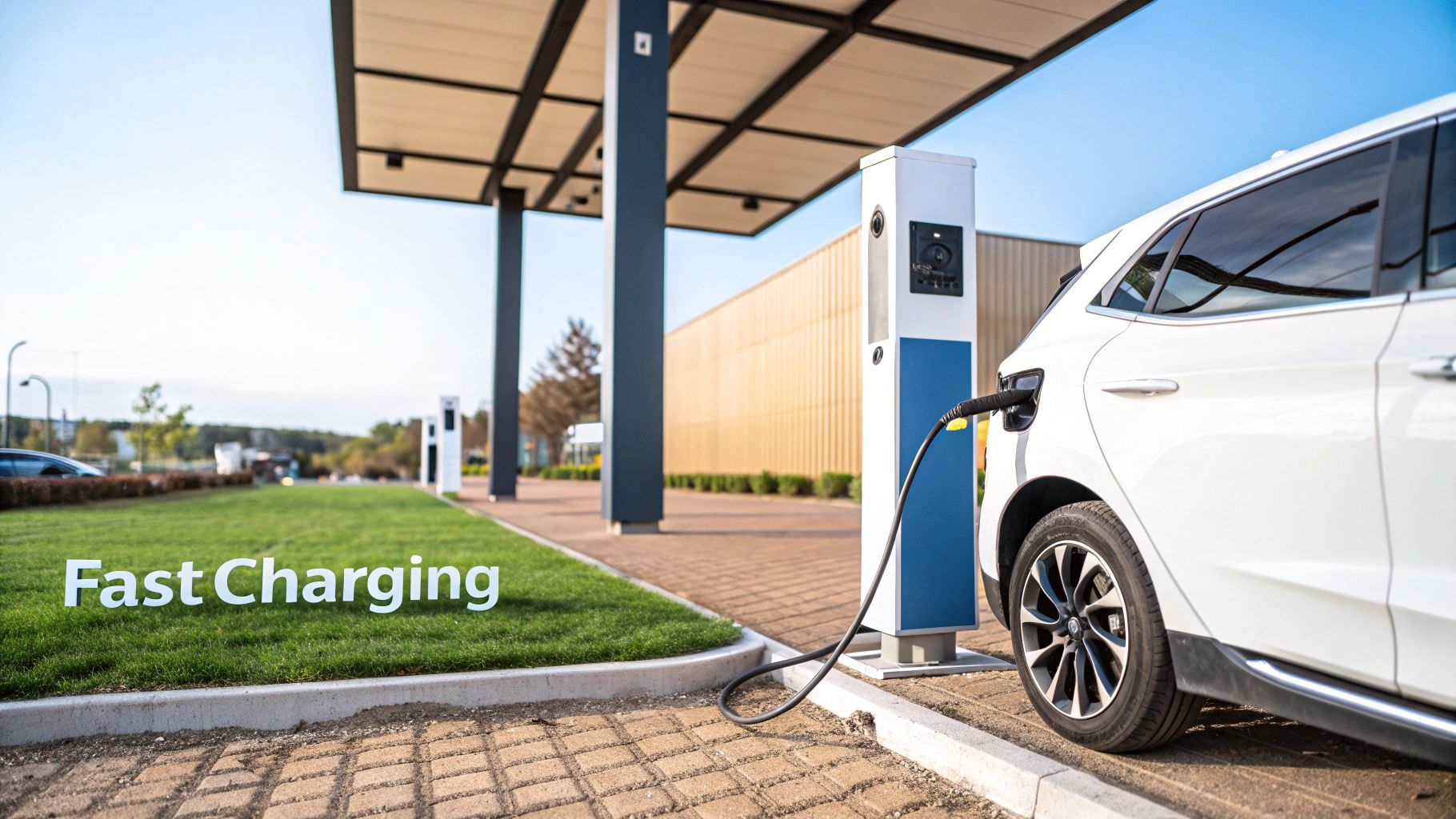
It’s why you can often add over 100 miles of range in under 30 minutes at a public rapid charging station. The physical design of the connectors even reflects their purpose:
- AC Connectors (Type 2): These are smaller and lighter, made for handling lower power levels over longer periods.
- DC Connectors (CCS & CHAdeMO): These are much chunkier and more robust, with extra pins built specifically to handle high-power DC safely.
Knowing whether you need a quick top-up or have hours to spare will determine which type of public charger and connector you should seek out. Choosing a CCS charger means you are aiming for speed while plugging into a standard Type 2 point is for a more leisurely top-up.
The UK's Charging Infrastructure Speeds
The UK’s charging infrastructure is growing to meet these different needs. As of July 2025, there were 84,218 public EV charging devices in the UK, which is a 30% increase from the previous year.
These chargers are broken down by speed, from slow ( 3-7 kWh ) and fast ( 8-49 kWh ) to rapid ( 50-149 kWh ) and ultra-rapid ( 150+ kWh ). While slower chargers still make up the majority, the number of ultra-rapid chargers has shot up by a massive 131% since 2023 . It’s a clear sign that the network is shifting towards faster, more convenient options. You can read the full findings on UK charging statistics to see the detailed breakdown.
This evolving network means drivers have more choices than ever. For daily commutes, a slow home charge is often all you need. But for those long-distance trips, knowing your car uses a CCS connector unlocks the growing number of ultra-rapid hubs that can get you moving again in the time it takes to grab a coffee.
The Rise of Mobile EV Charging
While fixed charging points are the norm, a far more flexible and powerful alternative is gaining serious traction across the UK. Mobile EV charging flips the script by bringing the power directly to the driver, offering a lifeline where fixed infrastructure is either missing or just plain inconvenient. This completely changes the game for drivers hit by range anxiety or, worse, find themselves stranded with a flat battery.
Think of it like a roadside assistance service that delivers a rapid charge instead of a tow truck. These van-mounted units can get drivers back on their way in minutes, turning a potentially day-ruining disaster into a minor hiccup. It's a brilliantly practical application of modern charging tech.
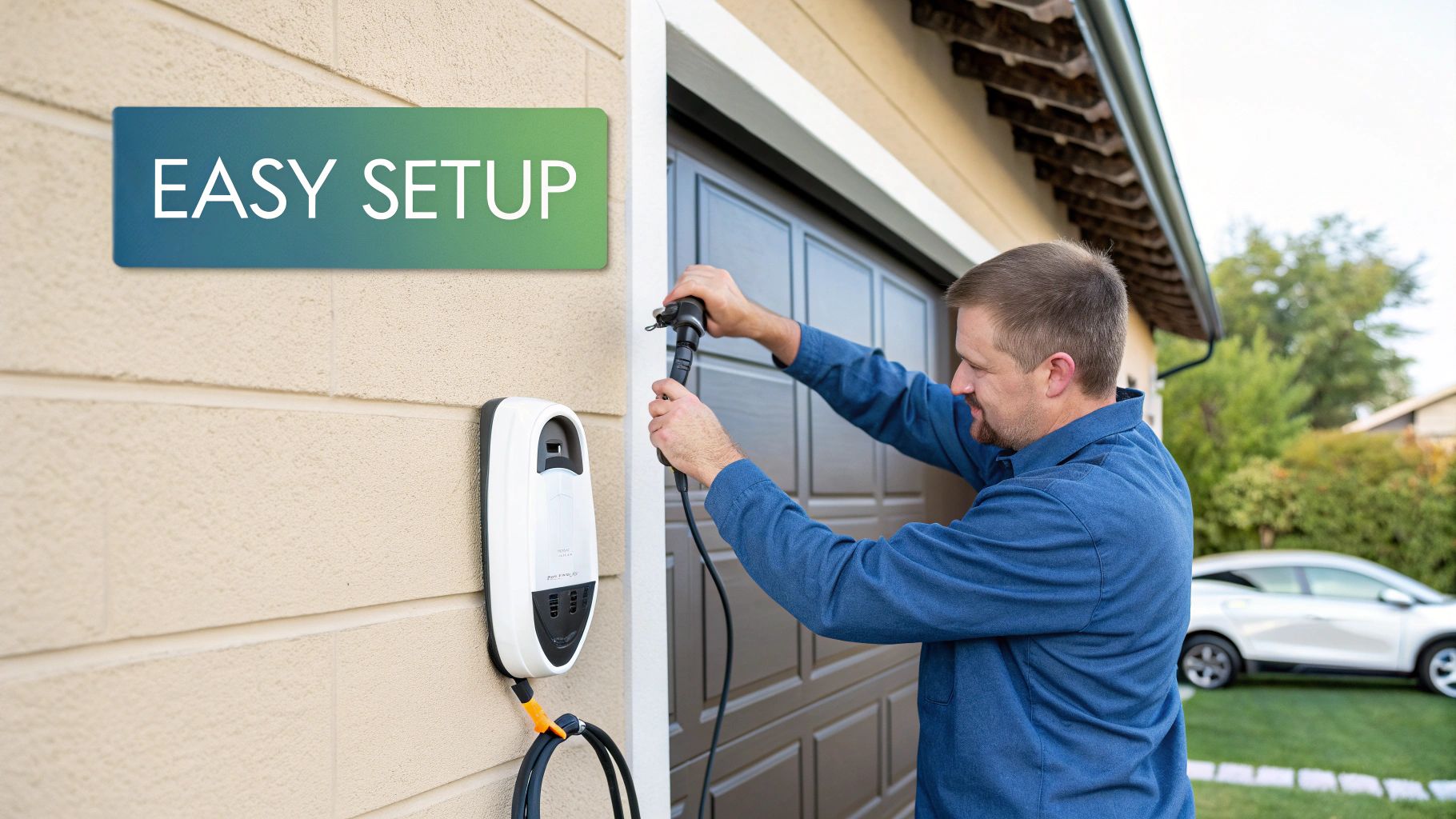
But this isn't just about bailing out stranded motorists. This service creates a massive business opportunity by plugging the gaps in our current charging network. By providing on-demand power, mobile charging operators can tap into a huge and growing market and build a very profitable enterprise.
A Lucrative Opportunity for Operators
For anyone looking to get into the EV space, operating a mobile charger opens up multiple revenue streams, making it an incredibly attractive business model. The chance to build a profitable enterprise comes from offering a premium, ultra-convenient service that customers are more than happy to pay for.
The financial upside is clear. An operator can build a successful business by targeting situations where permanent chargers just aren't practical or available. It's this flexibility that is the model's greatest strength.
For an operator, a mobile EV charging unit is more than just equipment; it's a business in a box. It provides the ability to deliver a high-demand service with relatively low overheads compared to installing and maintaining a fixed charging station.
A single mobile unit can cover a wide area, pulling in income from all sorts of places. These can include:
- Emergency Roadside Assistance: Offering a rapid top-up to stranded EV drivers at a premium rate.
- Fleet Charging Services: Providing scheduled, on-site charging for commercial fleets, like delivery vans or private hire vehicles.
- Event Power Solutions: Supplying temporary charging facilities at festivals, concerts and other outdoor events.
- Dealership and Garage Support: Helping out car dealerships or repair shops that need a temporary charging boost.
Each one of these scenarios is a chance to earn good money. An operator might set a flat call-out fee plus a per-kWh rate, allowing them to earn upwards of £80-£120 per call-out . With the capacity to handle multiple jobs a day, the potential daily revenue quickly becomes compelling. This business model is explored in more detail in our complete guide to stationary vs mobile charging solutions , which breaks down the financial benefits.
The Business Case for Mobile Charging
Running a mobile EV charging service is more than just a helping hand for stranded drivers—it’s a genuinely profitable business model. For entrepreneurs and fleet operators, it’s a chance to get ahead in a growing market by plugging the obvious gaps in the UK’s fixed charging network. This kind of venture thrives because it offers a premium convenience that people are more than happy to pay for.
The financial side is refreshingly straightforward. With just one mobile unit, an operator can open up several lucrative income streams, turning pure flexibility into profit. This isn't about trying to compete with fixed charging stations; it's about serving entirely different, often more urgent, needs.
Unlocking Diverse Revenue Streams
The real strength of the business is its ability to deliver power exactly where and when it's needed. This opens up opportunities that static infrastructure simply can't touch, from emergency call-outs to planned corporate services.
A mobile charging business can bring in serious income from multiple angles:
- Emergency Call-Outs: This is the most obvious and often the most profitable service. An EV driver with a flat battery is a customer in need. They’ll gladly pay a premium for a quick charge to get them moving again, especially when the alternative is the cost and hassle of a tow truck.
- Contracted Fleet Services: Businesses running electric van or car fleets depend on reliable charging. You can secure contracts to provide scheduled, on-site top-ups, ensuring their vehicles are always ready for the day's work without them having to install expensive fixed charge points.
- Event and Venue Partnerships: Think about festivals, conferences and big outdoor events. They attract huge numbers of EV drivers. Partnering with organisers to set up temporary charging facilities creates a captive market and a fantastic income stream over a single weekend.
Maximising Profit Per Charge
Getting your pricing strategy right is key. Most operators use a hybrid model that works well: a flat service or call-out fee combined with a per-kilowatt-hour (kWh) rate for the energy itself. This ensures your costs are covered while reflecting the true value of the convenience you're providing.
A single emergency call-out can realistically bring in between £80 and £120 . Just a few of those jobs a day can add up to a daily revenue of several hundred pounds, which really highlights the strong financial case for this business model.
By carefully targeting underserved city areas or rural spots far from the nearest rapid charging hub, an operator can become an essential local service. The business succeeds by turning a driver's problem into a profitable, on-demand solution. With the right strategy, a mobile EV charger connector becomes the key tool for a successful and scalable business.
The Future of EV Connector Technology
The world of EV charging never stands still and the humble connector is no exception. The technology you’re using today is really just a snapshot in time. As cars get smarter and the demand for faster, more convenient power grows, the connectors themselves are evolving right alongside them.
For drivers in the UK, this means looking beyond today's standards to a future that promises even greater efficiency and simplicity. While the industry is largely settling on CCS as the go-to for rapid charging, new innovations are already on the horizon.
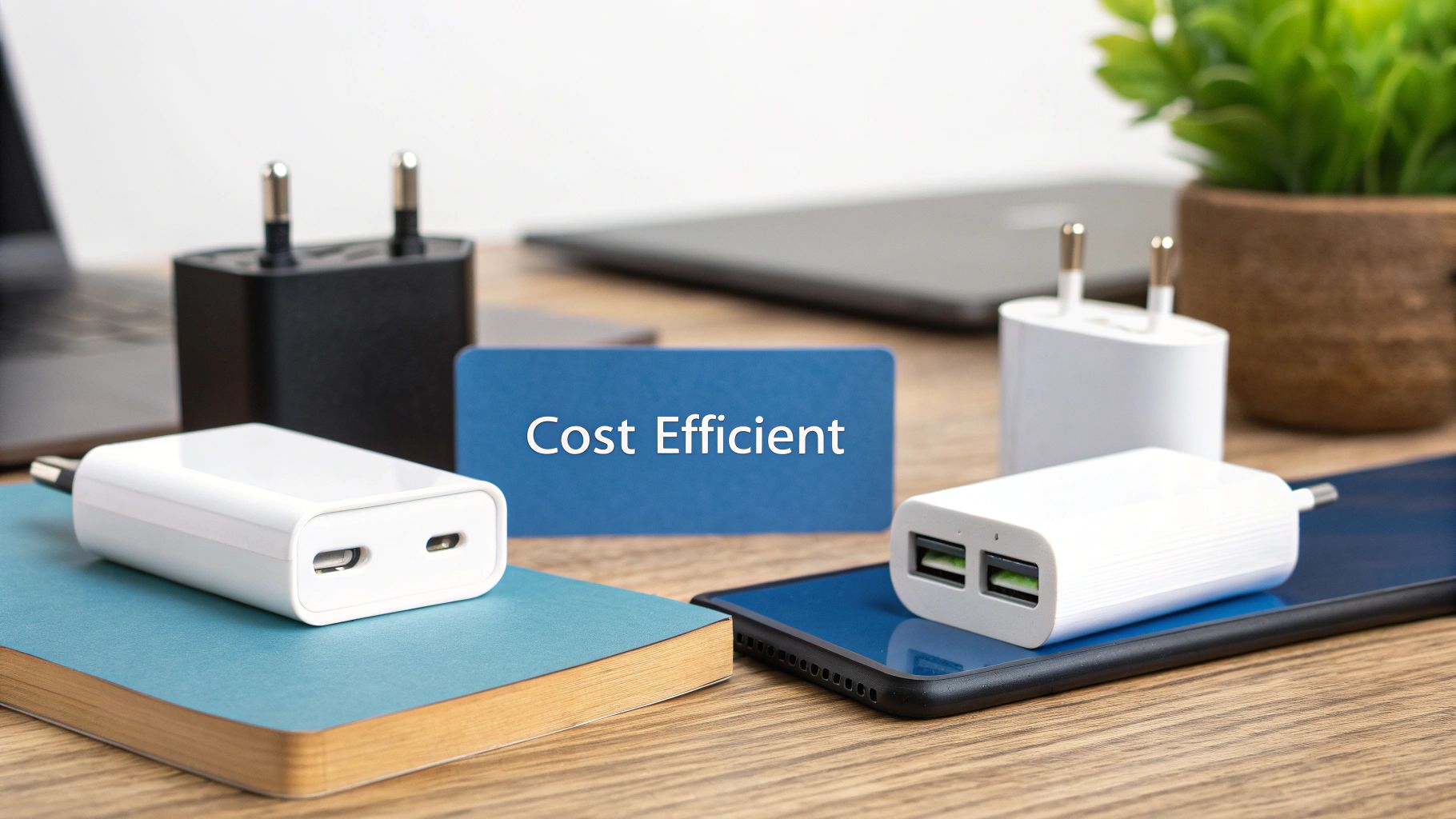
This progress is vital to keep up with the huge growth in electric vehicle adoption. The UK’s charging equipment market is set to expand dramatically, growing from around 50,640 units in 2024 to an estimated 169,150 units by 2030 . This explosion, driven by both consumer demand and government policy, ensures that our infrastructure will be ready for the vehicles of tomorrow. You can dig into more data on the UK vehicle charging equipment market to see the full forecast.
Innovations on the Horizon
The most talked-about development has to be wireless inductive charging. Imagine just parking your car over a specific spot in your garage or a public car park and having it start charging automatically. No cables, no fuss. This technology, which works much like a modern smartphone's wireless charger, points to a future of ultimate convenience.
Another game-changer is bidirectional charging, often called Vehicle-to-Grid (V2G). This technology will allow your car to do more than just draw power from the grid—it will be able to send it back.
With V2G, your car’s battery effectively becomes a mobile power pack for your home. During a power cut or peak energy pricing times, you could power your house directly from your vehicle, saving money and improving energy security.
These future technologies show how the role of the EV is expanding. It’s moving from being just a mode of transport to becoming an integral part of our home energy ecosystem, all powered by the next generation of charging technology.
Got Questions About EV Connectors?
Even after you get the hang of charging, a few common questions tend to pop up. It happens to everyone, from new owners to seasoned EV drivers. Getting clear, straightforward answers makes all the difference, whether you're planning your charging routine or out on the road.
Let's clear up some of the most frequent points of confusion around EV charger connectors.
What's the Standard EV Charger Connector in the UK?
It’s actually pretty simple these days. For AC charging at home and most public spots—think supermarkets or car parks—the Type 2 connector is the universal standard across the UK and Europe. This is the one you'll use for overnight top-ups.
For the faster DC rapid charging, the CCS (Combined Charging System) connector is now the go-to standard for almost all new cars and charging stations.
Can I Use an Adaptor for Different Connector Types?
Yes, but it depends on what you’re trying to connect. Adaptors can be a lifesaver. For instance, if you have an older imported car with a Type 1 port, a simple adaptor will let you use the far more common Type 2 cables.
However, trying to adapt between the big DC rapid charging standards like CCS and CHAdeMO is a different story. It's technically complex and not really a practical option for everyday drivers.
Tesla drivers are a great example of smart adaptor use. Many carry a CCS adaptor, which opens up a huge network of public rapid chargers beyond Tesla's own Superchargers. It's a small tool that massively expands their options on long journeys.
How Do I Know Which Connector My Car Uses?
The easiest way is to check your car’s manual but honestly, just have a look at the charging port on your vehicle. If you've bought a modern electric car in the UK, it will almost certainly have a Type 2 socket for your day-to-day AC charging.
If your car also supports rapid charging, you'll see a larger CCS socket. The clever part about the CCS design is that it includes the Type 2 port in its upper section, giving you one socket that handles both AC and DC charging.
Are you looking to enter the profitable mobile charging market? ZAPME provides cutting-edge, reliable mobile EV charging units that empower you to deliver on-demand power wherever it's needed. Discover our solutions and start your business today.

